
|
Brightened rapidly, and it reached to 5 mag in early June (June 5, Yoshimi Nagai). It will approach to the sun down to 0.4 A.U. in July, and it was expected to reach up to 2-3 mag. However, its brightening has stopped after that. It was 4.9 mag in late June (June 24, Carlos Labordena). It was faint as about 6 mag on July 2 (Todd Augustyniak). Now it is not observable. In the Southern Hemisphere, it will appear in the morning sky at 9 mag in late Augut. Then it keeps observable while fading rapidly. In the Northern Hemisphere, it is will never be observable again.
Date(TT) R.A. (2000) Decl. Delta r Elong. m1 Best Time(A, h)
July 24 8 42.86 6 1.2 1.597 0.678 15 5.8 20:49 (115,-23)
July 31 8 58.07 -1 27.2 1.682 0.811 20 6.5 20:41 (110,-29)
|

|
It passes the perihelion in August. But the condition of this apparition is bad. It is not observable in the Northern Hemisphere. In the Southern Hemisphere, it appears in the evening sky at 9 mag in late August, then it will keep observable while fading rapidly.
Date(TT) R.A. (2000) Decl. Delta r Elong. m1 Best Time(A, h)
July 24 7 34.30 25 15.8 1.452 0.487 10 8.9 3:23 (231, -8)
July 31 8 33.89 20 37.4 1.390 0.379 2 8.1 3:30 (230,-15)
|

|
Brightened rapidly. Now it is so bright as 8.5 mag (July 18, Marco Goiato). It keeps observable bright as 9-10 mag for a long time until autumn. A thin straight dust trail is visible.
Date(TT) R.A. (2000) Decl. Delta r Elong. m1 Best Time(A, h)
July 24 0 45.87 -8 20.8 0.693 1.437 113 9.2 3:23 (333, 43)
July 31 1 0.65 -9 16.5 0.677 1.449 116 9.3 3:30 (340, 44)
|
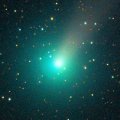
|
It brightened up to 7.9 mag in April and May (May 5, Juan Jose Gonzalez). Now it is fading. But it is still bright as 9.4 mag (July 18, Juan Jose Gonzalez). It keeps observable for a long time until when it fades out in the Northern Hemisphere. It will be visible visually until autumn, although it will be low in July.
Date(TT) R.A. (2000) Decl. Delta r Elong. m1 Best Time(A, h)
July 24 7 54.92 57 20.6 2.557 1.858 37 11.1 3:23 (206, 13)
July 31 8 0.35 55 58.5 2.609 1.919 38 11.3 3:30 (210, 15)
|

|
It brightened up to 15.5 mag in January (Jan. 31, C. Rinner, F. Kugel). It is not observable now. The condition of this apparition is bad. It will reach up to 11-12 mag from spring to autumn, but it is not observable.
Date(TT) R.A. (2000) Decl. Delta r Elong. m1 Best Time(A, h)
July 24 7 13.69 17 51.0 2.344 1.381 14 11.7 3:23 (240,-10)
July 31 7 36.95 16 15.0 2.352 1.398 15 11.8 3:30 (243, -9)
|

|
It reached up to 7.7 mag in last summer (Aug. 13, Chris Wyatt). It is fading now. It has already faded down to 11.9 mag (July 7, Marco Goiato). In the Southern Hemisphere, it keeps observable for a long time after this. In the Northern Hemisphere, it is only observable in the extremely low sky. It will be getting lower gradually, then it will never be observable again.
Date(TT) R.A. (2000) Decl. Delta r Elong. m1 Best Time(A, h)
July 24 18 8.44 -47 33.5 3.889 4.738 142 12.3 21:59 ( 0, 7)
July 31 17 56.80 -47 47.7 4.003 4.783 135 12.4 21:20 ( 0, 7)
|
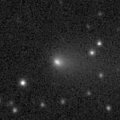
|
Now it is 11.5 mag (July 18, Juan Jose Gonzalez). It will keep 12-13 mag until autumn. But it locates somewhat low in the Northern Hemisphere.
Date(TT) R.A. (2000) Decl. Delta r Elong. m1 Best Time(A, h)
July 24 21 1.44 -31 49.7 1.603 2.594 163 12.8 0:57 ( 0, 23)
July 31 20 56.02 -32 27.6 1.613 2.609 165 12.8 0:24 ( 0, 23)
|

|
Brightening rapidly. Now it is 15.3 mag (July 23, A. Novichonok and L. Elenin). A bit fainter than expected. This apparition is best condition. It will approach to the earth down to 0.12 A.U. in October, and brighten up to 5 mag. It will be visible with naked eyes. In the Northern Hemisphere, it keeps observable all through this apparition until 2011 June when it fades down to 17 mag.
Date(TT) R.A. (2000) Decl. Delta r Elong. m1 Best Time(A, h)
July 24 22 22.52 20 32.9 0.801 1.639 128 13.4 2:17 ( 0, 75)
July 31 22 27.28 23 19.8 0.715 1.577 130 12.9 1:54 ( 0, 78)
|
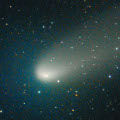
|
It reached up to 9.2 mag in March (Mar. 20, Marco Goiato). Now it is fading. It has already faded down to 12.2 mag (July 11, Marco Goiato). It keeps observable in a good condition for a long time. It keeps observable until autumn when it fades down to 16 mag.
Date(TT) R.A. (2000) Decl. Delta r Elong. m1 Best Time(A, h)
July 24 14 52.86 -12 36.6 1.661 2.142 103 13.4 20:49 ( 37, 34)
July 31 15 2.15 -13 32.2 1.772 2.181 99 13.7 20:41 ( 39, 32)
|

|
It was bright as 11.8 mag still on June 3 (Juan Jose Gonzalez). Now it is not observable in the Northern Hemisphere. It will be unobservable soon also in the Southern Hemisphere. It will appear in the morning sky again in October.
Date(TT) R.A. (2000) Decl. Delta r Elong. m1 Best Time(A, h)
July 24 9 56.19 9 38.1 7.109 6.222 27 14.2 20:49 (107, -7)
July 31 10 0.87 9 10.1 7.155 6.223 21 14.2 20:41 (109,-10)
|
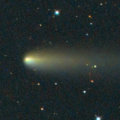
|
It brightened up to 9.5 mag in January (Jan. 13, Juan Jose Gonzalez). Now it is fading rapidly. But it is still bright as 14.1 mag (July 18, Hiroshi Abe). It will be observable in good condition for a long time after this in the Northern Hemisphere. It keeps visible visually until summer. In mid March, the nuclear fragmentation was observed.
Date(TT) R.A. (2000) Decl. Delta r Elong. m1 Best Time(A, h)
July 24 14 48.06 52 35.6 3.906 3.853 79 14.7 20:49 (137, 61)
July 31 14 53.36 51 6.6 3.994 3.909 77 14.8 20:41 (133, 60)
|

|
Now it is 14.8 mag (July 16, Siding Spring Survey). It is expected to keep so bright as 6-8 mag for a long time from 2011 to 2012, and to be observable in good condition in the Northern Hemisphere. In 2010, it is observable in good condition in the Southern Hemisphere while brightening slowly. It locates low in the Northern Hemisphere, but it keeps observable until the end of 2010.
Date(TT) R.A. (2000) Decl. Delta r Elong. m1 Best Time(A, h)
July 24 23 46.28 -35 4.6 5.218 5.932 130 14.8 3:23 (356, 20)
July 31 23 41.49 -35 39.8 5.094 5.872 136 14.7 3:09 ( 0, 19)
|

|
Now it is very bright as 14.2 mag (July 8, Toni Scarmato). Maybe it is 13 mag visually. It keeps observable at 14-15 mag for a long time in 2010.
Date(TT) R.A. (2000) Decl. Delta r Elong. m1 Best Time(A, h)
July 24 17 28.40 42 9.6 4.138 4.544 107 15.2 21:20 (180, 83)
July 31 17 26.46 41 53.3 4.167 4.537 105 15.2 20:50 (180, 83)
|

|
Now it is 15.3 mag (July 18, Hiroshi Abe). It will be observable at 13-14 mag for a long time from 2011 to 2012. In 2010, it is observable at 15-16 mag in good condition from spring to autumn.
Date(TT) R.A. (2000) Decl. Delta r Elong. m1 Best Time(A, h)
July 24 21 21.39 1 12.1 6.018 6.937 152 15.2 1:17 ( 0, 56)
July 31 21 15.14 0 49.8 5.948 6.904 158 15.2 0:43 ( 0, 56)
|
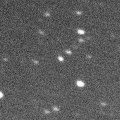
|
Now it is 15.0 mag (June 2, Hidetaka Sato). It keeps bright as 14-15 mag for a long time after this until 2013. It is observable in good condition in the Southern Hemisphere. However, it is not observable in the Northern Hemisphere.
Date(TT) R.A. (2000) Decl. Delta r Elong. m1 Best Time(A, h)
July 24 14 22.95 -47 43.7 6.294 6.652 106 15.2 20:49 ( 25, 0)
July 31 14 21.55 -47 38.2 6.363 6.624 100 15.2 20:41 ( 28, -2)
|

|
Chris Wyatt reported it was visible visually at 11.3 mag on Apr. 25. But no other observations have been reported. The condition of this apparition is very bad. It will never be observable after this.
Date(TT) R.A. (2000) Decl. Delta r Elong. m1 Best Time(A, h)
July 24 7 53.48 15 38.4 2.171 1.167 6 15.4 3:23 (235,-18)
July 31 8 16.89 13 50.7 2.245 1.244 7 16.0 3:30 (238,-17)
|
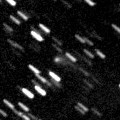
|
Now it is 16.5 mag (July 11, C. Rinner, F. Kugel). It keeps observable while fading gradually, and it will be fainter than 18 mag in November.
Date(TT) R.A. (2000) Decl. Delta r Elong. m1 Best Time(A, h)
July 24 4 49.79 55 35.2 2.822 2.335 51 16.3 3:23 (222, 33)
July 31 5 10.97 57 19.1 2.821 2.381 54 16.4 3:30 (220, 36)
|
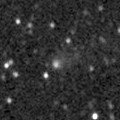
|
It reached up to 14.3 mag and became visible visually in May (May 21, Alan Hale). Now it is fading. It has already faded down to 15.7 mag (July 6, Mt. Lemmon Survey). It keeps observable until September when it becomes fainter than 18 mag.
Date(TT) R.A. (2000) Decl. Delta r Elong. m1 Best Time(A, h)
July 24 16 35.07 -22 44.0 1.176 1.984 129 16.3 20:49 ( 6, 32)
July 31 16 42.67 -22 28.0 1.263 2.021 124 16.6 20:41 ( 9, 32)
|
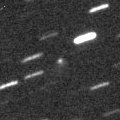
|
Now it is 16.7 mag (June 13, Hidetaka Sato). It will be observable at 17 mag in good condition in summer.
Date(TT) R.A. (2000) Decl. Delta r Elong. m1 Best Time(A, h)
July 24 20 5.23 -1 56.9 2.439 3.419 161 16.8 0:01 ( 0, 53)
July 31 19 48.02 -1 11.8 2.463 3.429 158 16.8 23:10 ( 0, 54)
|
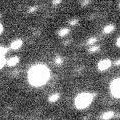
|
It was observed at 17 mag in summer and autumn in 2009. It will be observable again at 17 mag in good condition in summer and autumn also in 2010.
Date(TT) R.A. (2000) Decl. Delta r Elong. m1 Best Time(A, h)
July 24 2 41.07 21 35.5 2.574 2.536 76 17.1 3:23 (274, 46)
July 31 2 49.82 22 4.5 2.506 2.552 80 17.1 3:30 (278, 52)
|
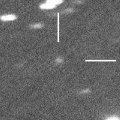
|
Now it is 17.4 mag (July 11, C. Rinner, F. Kugel). It keeps 17 mag for a long time from 2009 to 2012. It is observable in good condition in the Northern Hemisphere.
Date(TT) R.A. (2000) Decl. Delta r Elong. m1 Best Time(A, h)
July 24 2 30.47 21 5.8 8.381 8.246 78 17.3 3:23 (277, 48)
July 31 2 29.09 21 12.2 8.248 8.237 85 17.2 3:30 (283, 55)
|

|
Now it is 17.4 mag (July 20, Yasukazu Ikari). It keeps observable at 17-18 mag for a long time until 2011 summer.
Date(TT) R.A. (2000) Decl. Delta r Elong. m1 Best Time(A, h)
July 24 19 22.75 12 35.5 3.253 4.128 145 17.3 23:13 ( 0, 68)
July 31 19 9.63 12 50.9 3.266 4.110 141 17.3 22:32 ( 0, 68)
|
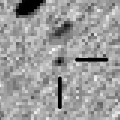
|
It has not been observe since 2009 August. It will be observable at 17 mag in good condition from autum to winter.
Date(TT) R.A. (2000) Decl. Delta r Elong. m1 Best Time(A, h)
July 24 2 11.80 28 4.1 2.369 2.425 80 17.7 3:23 (270, 55)
July 31 2 19.73 30 11.1 2.289 2.422 85 17.6 3:30 (270, 61)
|
|
![]()
 10P/Tempel 2
10P/Tempel 2 C/2009 K5 ( McNaught )
C/2009 K5 ( McNaught ) 43P/Wolf-Harrington
43P/Wolf-Harrington C/2006 W3 ( Christensen )
C/2006 W3 ( Christensen ) 65P/Gunn
65P/Gunn 103P/Hartley 2
103P/Hartley 2 81P/Wild 2
81P/Wild 2 29P/Schwassmann-Wachmann 1
29P/Schwassmann-Wachmann 1 C/2007 Q3 ( Siding Spring )
C/2007 Q3 ( Siding Spring ) C/2009 P1 ( Garradd )
C/2009 P1 ( Garradd ) C/2008 FK75 ( Lemmon-Siding Spring )
C/2008 FK75 ( Lemmon-Siding Spring ) C/2006 S3 ( LONEOS )
C/2006 S3 ( LONEOS ) C/2009 F4 ( McNaught )
C/2009 F4 ( McNaught ) 141P/Machholz 2
141P/Machholz 2 126P/IRAS
126P/IRAS P/2010 A5 ( LINEAR )
P/2010 A5 ( LINEAR ) C/2010 J2 ( McNaught )
C/2010 J2 ( McNaught ) 219P/2009 H1 ( LINEAR )
219P/2009 H1 ( LINEAR ) C/2008 S3 ( Boattini )
C/2008 S3 ( Boattini ) C/2009 UG89 ( Lemmon )
C/2009 UG89 ( Lemmon ) 223P/2009 L18 ( Skiff )
223P/2009 L18 ( Skiff )![]()



















